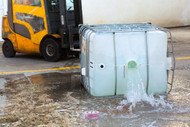The Importance of Proper Spill Containment
Posted by EnSafeCo on 8th Sep 2022
Putting Best Practices for spill containment in place - before there's a spill of hazardous and toxic materials – is important to protecting the health and safety of your workers. There are a few things to keep in mind when establishing these procedures, including ensuring that you have the right materials and that your employees are properly trained to use everything.
There are six main steps to ensuring that you're ready when a spill happens!
Store Chemicals Properly
Make sure that all chemicals used in your facility are properly put away or stable shelves. Do not store chemicals that can interact together – for example, bleach and ammonia, when combined, can form a toxic gas.
Use Accurate Labels On All Containers
Knowing what's inside all of your containers can help you understand how to properly clean them up. Whenever possible, store all chemicals in the original containers, and make sure that the MSDS data sheets for everything are nearby. If you have to place chemicals into another container for application, make sure that they are labeled correctly and that all your employees know how to properly transfer chemicals into new containers, in order to prevent small spills.
Use the Right Spill Containment Supplies
There are several different types of spill containment supplies you should always have on hand. Spill containment decks and pallets can come in a variety of shapes and sizes, appropriate for many industries. Spill kits can help quickly mop up liquid spills, while pallets and barrels can give your business a place to safely store the mess.
For the oil and petroleum industries, berms can come especially in handy when it comes to bigger spills. These barriers can prevent the spill from reaching other areas until you have a chance to safely clean it up. These also come with secondary containers to hold the mess, and many are lightweight and portable enough to move from job site to job site.
Conduct Regular Inspections of the Work Site
One of the best ways to prevent spills is to make sure that you aren't creating an environment where they can happen easily. Make sure that you conduct regular inspections, and log incidents where you spot leaks and areas where chemicals aren't stored properly.
Make Sure Containment Materials Can Be Transported Safely
Proper spill containment and clean-up also involve safely removing all the matter, mopping up the liquid, and cleaning the surfaces afterward t make sure that they're safe, and correctly disposing of the waste.
Having a place to put contaminated clean-up materials, such as a rolltop or outdoor spill pallet shed can help keep the spill and clean-up materials somewhere safe until it can be transferred to the right type of landfill.
Ensure All Employees are Well-Trained
Your staff can't properly clean up a spill if they don't know how. Make sure that everyone on your team understands how to use the spill containment kits from EnSafeCo, and that they're all aware of the safety measures that need to be in place when there's a hazardous materials spill.
EnSafeCo Can Help!
We, like our customers, are dedicated to protecting the environment, and our customers' bottom line. EnSafeCo.com offers products that provide environmental protection, personal safety, and we help to ensure your companies government compliance. Visit us online to view our catalogue of products and request a quote for materials today!

